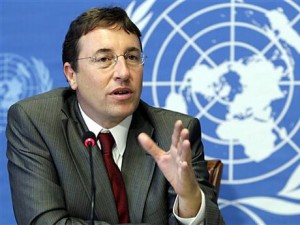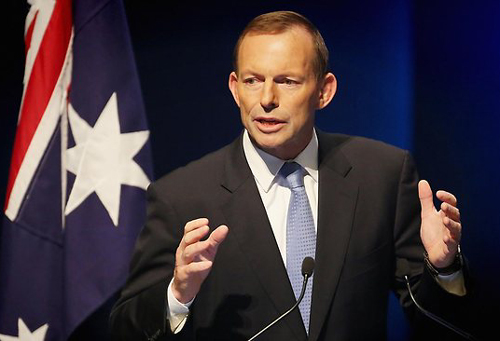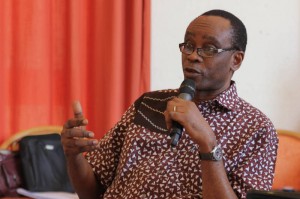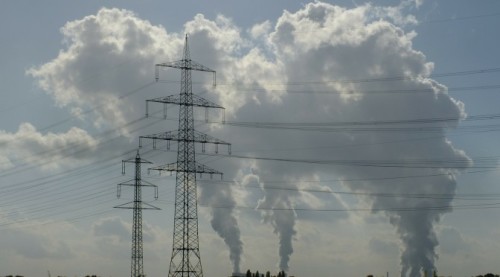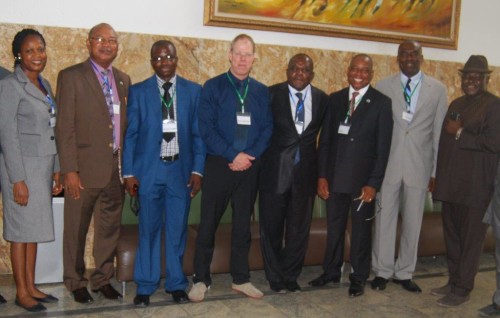Criticising Prime Minister Tony Abbott, the group highlights a range of comments, statements and quotes in an apparent bid to buttress its point.
· When the government abolished the carbon price in 2014, it was replaced with Direct Action – primarily a taxpayer-backed Emissions Reduction Fund (ERF).
· However, the fund is unlikely to achieve even a 5% emissions reduction by 2020. The first ERF auction held in April 2015 was hailed as a stunning move by the government. Assuming the cost for carbon emissions remains at the average of almost AUD$14 per tonne of CO2 as paid in the first auction, the $1.89 billion budgeted will buy another 135 million tonnes of emissions.
But even assuming all the 47.3 million tonnes bought in the first auction are delivered, and the price per tonne of carbon remains the same, then the total emissions reduction bought by the ERF will be around 182 million tonnes of CO2. This is 54 million tonnes (or about 23%) short of Australia’s overall target. However it is likely that this first auction has already picked most of the “low-hanging fruit.”
· As Mr. Abbott explained, the ERF is not actually about a 5% target: “The bottom line is we will spend as much as we have budgeted, no more and no less. We will get… as much emission reduction as we can for the spending we have budgeted.”
· There is also no timeline for the reductions. In fact, much of the 47 million tonnes bought in the first round of auctions won’t be delivered until after 2020.
· Almost all of the abatement to be delivered before 2020 from the first auction appears to be from projects that were already in place sometime before the ERF came along, or rely on a one-off land clearing permit regime.
· Manufacturers, miners and electricity generators (equivalent to more than 60% of Australia’s emissions) won’t have to reduce their emissions and may in fact be able to increase them, which could cancel out the emissions reductions. Direct Action’s “safeguards mechanism” has been watered down to the extent it effectively safeguards against industry having to do anything. A government issues paper said baselines for emissions would “reflect the highest level of reported emissions for a facility over the historical period 2009-10 to 2013-14”. If companies exceeded the baseline calculated that way, they could have their emissions averaged out of the next three years, or apply for a baseline “expansion”, or apply for an exemption, for example after a natural disaster.
· Elaine Prior, a senior analyst at the global investment bank Citigroup said: “It appears to us that the mechanism, as described in the consultation paper, is unlikely to impose any significant costs or constraints on companies … it also appears unlikely to make any significant positive contribution to Australia’s emissions reduction efforts.”
What is Australia’s level of ambition post-2020?
Australian Government: Australia has an existing national renewable energy target, a “national energy productivity plan” and national building and appliance energy standards.
· Australia’s recent ‘discussion paper’ does not mention a two degree goal, instead citing the IEA ‘new policies scenario’ which could result in upwards of 3.6 degrees warming.
· The government will set a post-2020 emissions reduction target without a policy. Its discussion paper asks what policies might be implemented to achieve a new target that are “complementary” to Direct Action. Direct Action may not have enough money to meet even the 5% target, and all analysis suggests it would be extremely difficult to “scale up” to a higher target.
· In May 2015, the Government cut Australia’s large-scale renewable energy target of 41,000 gigawatt hours of annual renewable energy production by 2020 to 33,000 gigawatt hours. Bloomberg New Energy Finance says investment in Australian projects will fall from an expected $20.6 billion by 2020 to $14.7 billion.
· The government is not including climate change in long-term planning exercises. The recent intergenerational report even claimed that some economic effects of climate change “may be beneficial – where regions become warmer or wetter this may allow for increased agricultural output, while others may be harmful”.
Does Australia have special circumstances?
Australian Government: Australia has special “national circumstances”, as “for the foreseeable future, Australia will continue to be a major supplier of crucial energy and raw materials to the rest of the world … At present, around 80% of the world’s primary energy needs are met through carbon-based fuels. By 2040, it is estimated that 74% will still be met by carbon-based sources.”
· Australia is already one of the largest per capita emitters on the planet and is refusing to pull its weight.
· Australia’s justification for it’s special circumstances is based on “new policies scenario” of the International Energy Agency’s world energy outlook 2014, which was a baseline calculation of what would happen if countries implemented only the policies announced at that time, a scenario which would pave the way for at least 3.6C of global warming.
Abbott Government – Highlights on climate and energy
Prime Minister Abbott was elected PM in September 2013 and quickly started dismantling Australia’s climate change framework, including:
- Moving to become the first country in the world to abolish the legislated price on carbon emissions
- Shutting down the Climate Commission, an independent panel of experts that provided information on how climate change is affecting the country
- Drastically reducing funding to the United Nations Environment Programmme (UNEP)
- Has successfully managed to massively reduce the country’s mandated 20% Renewable Energy Target (RET), bringing a number of major renewable energy companies and projects to their knees
Abbott opted not to send a representative to the COP 19 UN conference in Warsaw, a move described by former Executive Secretary of the UNFCCC Yvo de Boer as “puzzling”.
He appointed climate sceptic Dick Warburton to review Australia’s renewable energy target, in a move widely seen as first steps to weakening the target.
In a play out of the FIFA playbook, the Australian government has spent $100,000 on travel to lobby against UNESCO over the Great Barrier Reef listing in an attempt to protect their interests of coal development in the Galilee Basin.
Not only does the Coalition not vote against climate science, it blatantly ignores it. As many lesser developed countries have already pledged their Intended Nationally Determined Contributions (INDCs), the Abbott government seems to be endeavouring to do what the Howard government managed under the Kyoto Protocol. That is, to plead special consideration and avoid responsibility.
Meanwhile, the Coalition has directed $4m to fund an Australian climate consensus centre fronted by political scientist and climate change contrarian Bjorn Lomborg. The University selected turned down the offer of funding after an outcry from students, academics and the public.
In an attempt to qualify for renewable energy subsidies under the RET, the Australian government plans to allow the burning of native forest biomass. Not only will this burnt forest power be forced into direct competition with genuinely renewable forms of energy generation (wind and solar), but it will reduce the renewable energy certificates available for genuine low or no emission technologies by up to 15%.
In its recent budget, the Abbott government has yet again cut funding to climate research, with the National Climate Change Adaptation Research Facility a new addition to the list of climate and energy agencies to be halted in 2017. This government has already cut hundreds of millions of dollars from climate science, international climate finance and clean technology research programs. Critics say this sets Australia’s climate change action policies back to the 1990s.
The government is instead pushing ahead with a “Direct Action” policy, widely criticised as ineffective.
Australia is one of the leading countries opposing limits on coal finance in international discussions. A recent report reveals foreign governments have given Australia more than $4 billion to fund coal projects since 2007. In addition to global funding, Australian taxpayers have put up $1.4 billion to subsidise coal mines and power plants via the Export Finance and Insurance Corporation, a government bank that enables the finance of Australian projects in other countries.
Abbott attempted (and failed) to take climate change off the G20 agenda in 2014.
The United Nations world heritage body condemned Australia’s approval of the dredging and dumping of millions of tonnes of sludge for new coal ports in the waters of the Great Barrier Reef.
In an unprecedented move, the Abbott government applied to have sections of the Tasmanian Wilderness World Heritage Area delisted by the United Nations, incorrectly claiming it had been degraded.
The Federal government’s recent Energy White Paper is yet another indication of the massive missed opportunity to incentivise renewable technology, instead aligning Australia’s future in old, polluting technology.
Abbott’s personal approval rating has plummeted after just 18 months of rolling out and doing their best to destroy these meaningful climate and energy policies.
Abbott was recently criticised for a bizarre video he released on YouTube, in which he linked a commemoration of the 70th anniversary of WWII D-Day to his government’s policies, including cutting the taxes on carbon emissions and mining and saying that Australia is “open for business.”
John Oliver did a brilliant summary of Abbott gaffes, well worth watching as a backgrounder, describing him as “hard-line, right wing” and “religiously anti-immigration.
A range of Tony Abbott comments:
- “We don’t support, as a government, and as a Coalition, further lock ups of our forests. We just don’t support it. We have quite enough national parks, we have quite enough locked up forests already, in fact, in an important respect, we have too much locked up forest.”
- “Australia has had fires and floods since the beginning of time. We’ve had much bigger floods and fires than the ones we’ve recently experienced. You can hardly say they were the result of anthropic [sic] global warming.”
- “Coal is good for humanity, coal is good for prosperity, coal is an essential part of our economic future, here in Australia, and right around the world.”
- “The climate change argument is absolute crap, however the politics are tough for us because 80 per cent of people believe climate change is a real and present danger.”
- “Coal is vital for the future energy needs of the world. So let’s have no demonisation of coal. Coal is good for humanity. Coal is essential for the prosperity of the world. Energy is what sustains our prosperity, and coal is the world’s principal energy source and it will be for many decades to come.”
- “It sounds like common sense to minimise human impact on the environment and to reduce the human contribution to increased atmospheric-gas concentrations. It doesn’t make much sense, though, to impose certain and substantial costs on the economy now in order to avoid unknown and perhaps even benign changes in the future.
- “The climate has changed over the eons and we know from history, at the time of Julius Caesar and Jesus of Nazareth the climate was considerably warmer than it is now […] Climate change happens all the time and it is not man that drives those climate changes back in history. It is an open question how much the climate changes today and what role man plays.”
- “These so-called nasty big polluters are the people that keep the lights on. I mean, let’s not forget how essential these people are to the business of daily life.”
- “If you want to put a price on carbon, why not just do it with a simple tax?”
- “It is prudent to do what we reasonably can to reduce carbon emissions. But we don’t believe in ostracising any particular fuel and we don’t believe in harming economic growth.”
Comments from a cross-section of politics, NGOs, academics, firefighters, health professional, religious leaders etc in response to The Abbott Government’s stance on climate and energy.
Australian Greens Deputy Leader and climate change spokesperson, Senator Larissa Waters:
“Other countries, including the US and China, have asked very valid questions about the inadequacy of the Abbott Government’s Direct Action program and lowly emissions reduction target. In response, the Abbott Government has come up with a whole lot of spin and hot air in an embarrassing attempt to cover up its shameful inaction on climate change.”
The Climate Institute Deputy CEO, Erwin Jackson:
“The government’s response to other countries questions on the effectiveness of its domestic pollution reductions policy lack transparency and try to avoid accountability. The government appears to be inflating the impact of its actions to 2020 without providing any estimate of the pollution reductions it will deliver. Its responses raise more questions than it answers.”
Friends of the Earth Activist, Cam Walker:
“The renewables industry has been brought to the brink of collapse because of the extreme opinions of key players in the Coalition government and this reduced target will mean fewer jobs and investment in regional Australia, and less action on climate change than the original target,”
GetUp Campaigns Director, Paul Oosting:
“It’s hard to believe the government that said we’re open for business is now sending renewables investors packing. The RET’s been a big success for the country, doubling renewable electricity generation and reducing wholesale electricity prices. It’s time to balance out the multi-billion dollar subsidies to the fossil fuel industry with support for the fledgling, but fast growing renewables sector.”
The Australian Forests and Climate Alliance (AFCA) Member, Frances Pike:
“Decades of over-logging of public native forests has led to environmental degradation of vast tracts of native forest, loss of water yields from catchments and rain-making capacity. Australia now faces a wildlife crisis in many regions, and loss of habitat from logging is a major cause. The last thing we now need is forests being degraded and destroyed as a source of power production” said Ms Pike.
Solar Citizens National Director, Claire O’Rourke:
“Australians have been betrayed by the Abbott government’s pandering to the big power companies at the expense of ordinary families who are struggling with the cost of living. The Prime Minister’s repeated attacks on solar have put jobs and investment at risk and undermines the cheap, clean, sun-powered future Australians want.”
Greenpeace Australia Reef Campaigner, Shani Tager:
“UNESCO now joins a long line of scientists, banks, organisations and individuals who are deeply worried about the Reef’s health. The Australian government can’t talk about protecting the Reef while aggressively supporting the licensing of mega-mine and expansion of coal ports along the Great Barrier Reef coast.”
Former Leader of the Liberal party, Chair of AODP.net Dr John Hewson (Tony Abbott was a former staffer of Dr Hewson):
“The economic, environmental and health risks of climate change are very real. Prime Minister Abbott would be smarter to back Obama, who is likely to lead the international response to climate change, as a priority, for the rest of his presidential term.”
Former international oil, gas and coal industry executive, former chair of the Australian Coal Association and the former CEO of the Institute of Company Directors, Ian Dunlop:
“The omens are not good. The federal government remains in total denial that climate change will have any material impact on Australia’s future. Sensible climate policy has been dismantled, replaced with token gestures. Climate change does not feature in the policy reviews underway, with ludicrously Orwellian efforts being made to remove any reference to it throughout government.”
350.org Australia CEO, Blair Palese:
“As the world moves rapidly away from coal, oil and gas and toward clean energy, Tony Abbott’s lack of leadership on climate change has Australia shirking its global responsibility on the most important issue of our time. As the country with the most to gain by the take up of solar, wind, wave and geothermal energy, Abbott’s belief that ‘coal is good for humanity’ is relegating Australia to the energy dark ages.”
Greenpeace Australia Pacific CEO, David Ritter:
“The Abbott Government has consistently failed the responsibility test on climate change, leaving Australia as an embarrassing laggard in a world that is moving to act. Both the Australian people and the world deserve better than this from the Australian Government on climate change.”
Delegate of United Firefighter’s Union QLD, Queensland, Dean McNulty:
“Firefighters are right on the front lines of the climate threat. We need a leader who will stand and face the climate challenge with our international colleagues, not a leader who runs away.”
Oxfam Australia Climate Change Advocacy Coordinator, Dr Simon Bradshaw:
“Climate change is the single biggest challenge in the fight against poverty and hunger. Our region is home to some of the most vulnerable nations on earth, many of which are already struggling with shifting rainfall, sea level rise and more extreme weather. The Australian Government is both swimming against the tide of international action and working against the needs of poor people in developing countries. Renewable energy, not coal, is the key to reducing poverty and supporting inclusive economic growth throughout the developing world.”
Climate and Health Alliance (CAHA) President, Dr Liz Hanna:
“Health and medical professionals are increasingly sounding the alarm on the Australian government’s backward steps on action to tackle climate change, given the serious health impacts for people in Australia and around the world from failing to cut emissions. This, compounded by the Abbott government position on promoting the coal industry, is inconsistent with its duty to prevent further climate change and avoiding known risks to health and wellbeing.”
Australian Religious Response to Climate Change President, Thea Ormerod:
“In a globalised world, it is morally unacceptable for the leaders of individual countries to take a stand which would frustrate a global deal on climate change. It is all the more reprehensible when such a stand serves the interests of the wealthy, and will come at the human cost of the poor and future generations.”
The Climate Institute CEO, John Connor:
“Government and business figures have often opposed climate and energy initiatives on the basis that Australia shouldn’t “go it alone”. This budget shows that if there’s anywhere we’re at risk of going alone, it’s backwards.” This latest budget locks in the benefits that polluters now can to continue polluting for free, while loading up taxpayers and a supposedly stressed budget with the task of paying for emissions reductions.”
Australian Conservation Foundation Energy Analyst, Tristan Knowles:
“It’s hard to believe a government of an advanced developed nation in the second decade of the 21st Century can release a vision for an energy future that pays so little attention to climate change. The energy white paper could have provided a roadmap for a sustainable energy future, but instead it was merely a rubber stamp on Australia’s old dinosaur industries and further proof that the current government has its head in the sand on energy policy.”
Former Leader of the Australian Greens, Senator for Tasmania, Christine Milne:
“The depth of this government’s denial is alarming. They’re condemning Australia to economic dislocation, to being way behind the rest of the word, and to making life harder and more dangerous for everyone in our region, as extreme fires and storms intensify […] The Abbott government does not accept the science, continues to support coal expansion and can’t see that they will be left behind as plenty of countries commit to a fossil fuel free world.”
Daniel Spencer Australian Youth Climate Coalition (AYCC):
“The Great Barrier Reef has lost 50% of its coral cover over the last 30 years, in large part due to climate change. It’s a warning sign that carbon-intensive fossil fuels must remain in the ground. Citizens and investors alike are sending a clear message that the world has to move beyond coal. Australia should be leading this shift by creating jobs in clean energy instead of trying to build unviable coal ports on the Great Barrier Reef.”


